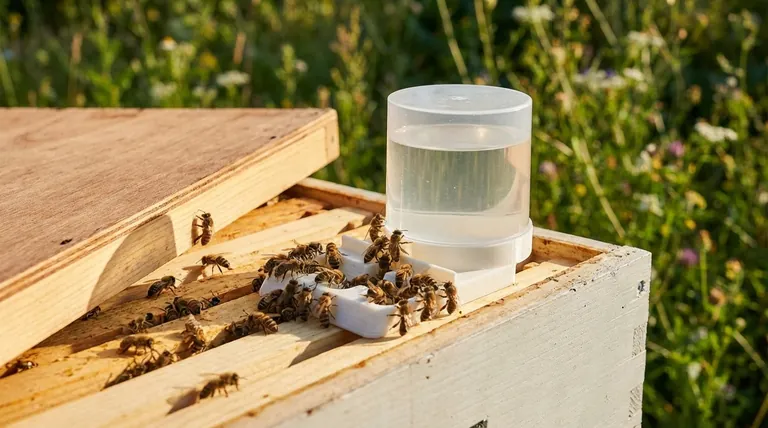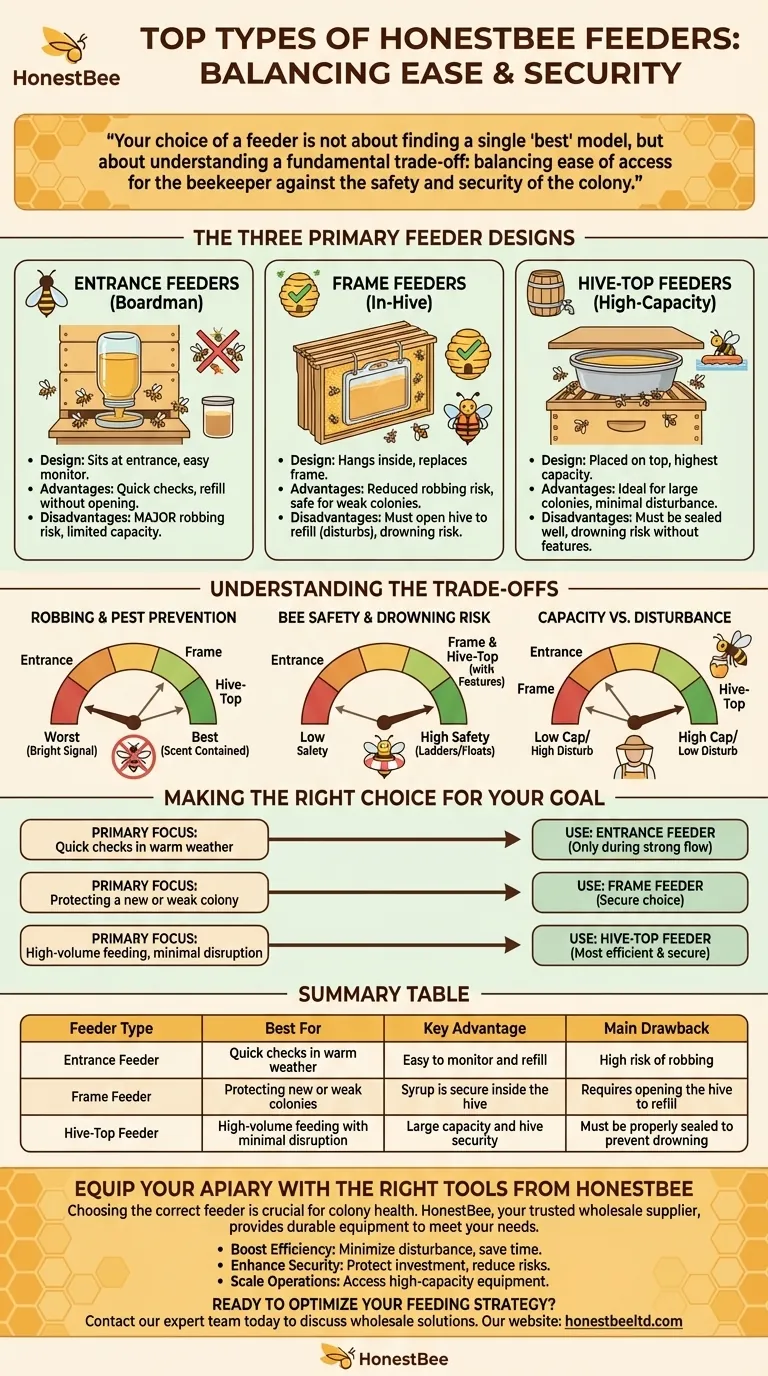The three principal types of honey bee feeders are Entrance Feeders, Hive-Top Feeders, and Frame Feeders. Each is designed for a different purpose, balancing factors like capacity, bee safety, and the risk of attracting pests or robber bees from other colonies.
Your choice of a feeder is not about finding a single "best" model, but about understanding a fundamental trade-off: balancing ease of access for the beekeeper against the safety and security of the colony.

The Three Primary Feeder Designs
Choosing the right feeder requires understanding how each design interacts with the hive's natural environment and workflow. The location of the feeder—outside the entrance, inside the hive, or on top—is the most critical distinguishing factor.
Entrance Feeders
Also known as Boardman feeders, these simple devices sit at the entrance of the hive. They typically use an inverted mason jar to dispense syrup into a small tray the bees can access from inside.
This design is very easy to monitor and refill without opening the hive. You can see the syrup level at a glance.
However, their position at the entrance makes them a major liability for inciting robbing, where bees from other hives or wasps are attracted to the food source and attack the colony. They also offer a very limited capacity.
Frame Feeders
A frame feeder, or in-hive feeder, is a plastic container shaped like a standard hive frame. It hangs inside the brood box or super, taking the place of one or two frames.
Because the syrup is entirely inside the hive, the risk of robbing is significantly reduced. This makes them a much safer option for weaker colonies.
The main drawback is that you must open the hive to check the level and refill the feeder, which disturbs the colony. Many modern frame feeders include ladders or textured interior walls to help prevent bees from drowning.
Hive-Top Feeders
As the name implies, hive-top feeders are placed on top of the uppermost hive box, directly under the main hive cover. They come in various styles, including large basin types or bucket feeders that use gravity.
These feeders offer the highest capacity, making them ideal for feeding large colonies or preparing a hive for winter. They can be refilled with minimal disturbance to the bees below.
Their enclosed design offers excellent protection against robbing. However, you must ensure they are properly sealed, and cheaper models without safety features like floats or screened-off areas can pose a drowning risk.
Understanding the Trade-offs
No feeder is perfect for all situations. A beekeeper's preference is often shaped by their climate, the strength of their colonies, and their management style. The key is to weigh the pros and cons based on your specific needs.
Robbing and Pest Prevention
The location of the food source is the number one factor in preventing robbing. Entrance feeders are the worst offenders, acting as a bright, sugary signal to any nearby colonies or pests.
Frame feeders and hive-top feeders are far superior for hive security because they keep the syrup's scent contained within the hive, making it difficult for outsiders to locate.
Bee Safety and Drowning Risk
Any open container of syrup is a drowning hazard for bees. It's a critical consideration, especially when feeding a small or weak colony where every bee counts.
Well-designed frame and hive-top feeders incorporate safety mechanisms like floating rafts, internal ladders, or rough surfaces that allow bees to access the syrup without falling in. Simple entrance feeders offer little to no protection.
Capacity vs. Colony Disturbance
Your feeding goals determine capacity needs. For minor supplemental feeding, a small-capacity feeder is fine. For extensive fall feeding, capacity is critical.
Hive-top feeders excel here, holding a gallon or more of syrup and requiring infrequent refills. In contrast, frame feeders require you to suit up and open the hive each time you refill, causing more stress to the colony.
Making the Right Choice for Your Goal
Select your feeder based on a clear objective for your colony's health and your own time commitment.
- If your primary focus is quick checks in warm weather: An entrance feeder can work, but only during a strong nectar flow when the risk of robbing is low.
- If your primary focus is protecting a new or weak colony: A frame feeder is a secure choice that minimizes the risk of attracting robbers.
- If your primary focus is high-volume feeding with minimal disruption: A hive-top feeder is the most efficient and secure option for established colonies.
Ultimately, the right feeder is a tool that empowers you to support your bees safely and effectively.
Summary Table:
| Feeder Type | Best For | Key Advantage | Main Drawback |
|---|---|---|---|
| Entrance Feeder | Quick checks in warm weather | Easy to monitor and refill | High risk of robbing |
| Frame Feeder | Protecting new or weak colonies | Syrup is secure inside the hive | Requires opening the hive to refill |
| Hive-Top Feeder | High-volume feeding with minimal disruption | Large capacity and hive security | Must be properly sealed to prevent drowning |
Equip Your Apiary with the Right Tools from HONESTBEE
Choosing the correct feeder is crucial for colony health and productivity. As a trusted wholesale supplier for commercial apiaries and distributors, HONESTBEE provides durable, well-designed beekeeping equipment to meet your specific operational needs.
We help you:
- Boost Efficiency: Minimize hive disturbance and save valuable time during feeding.
- Enhance Security: Protect your investment by reducing the risk of robbing and drowning.
- Scale Operations: Access high-capacity equipment perfect for large-scale beekeeping.
Ready to optimize your feeding strategy? Contact our expert team today to discuss your equipment requirements and discover how our wholesale solutions can support your success.
Visual Guide

Related Products
- HONESTBEE Entrance Bee Feeder Professional Hive Nutrition Solution for Beekeeping
- HONESTBEE Entrance Bee Feeder Efficient Hive Front Liquid Feeding Solution for Beekeeping
- Classic Boardman Entrance Bee Feeder Hive Front Feeding Solution
- Professional In-Hive Frame Bee Feeder by HONESTBEE
- Boardman Entrance Bee Feeder Durable Galvanized Steel and Wood Construction for Beekeeping
People Also Ask
- How does the entrance feeder method work? A Guide to Simple But Risky Hive Feeding
- What are the different types of honey bee feeders? Choose the Right Feeder for Your Hive
- What is an entrance feeder? A Guide to Its Simple Design and High Robbing Risk
- How do you make an entrance feeder for bees? A Guide to Safe & Effective Hive Feeding
- How to make an entrance feeder for bees? A DIY Guide for Safe & Effective Feeding



















